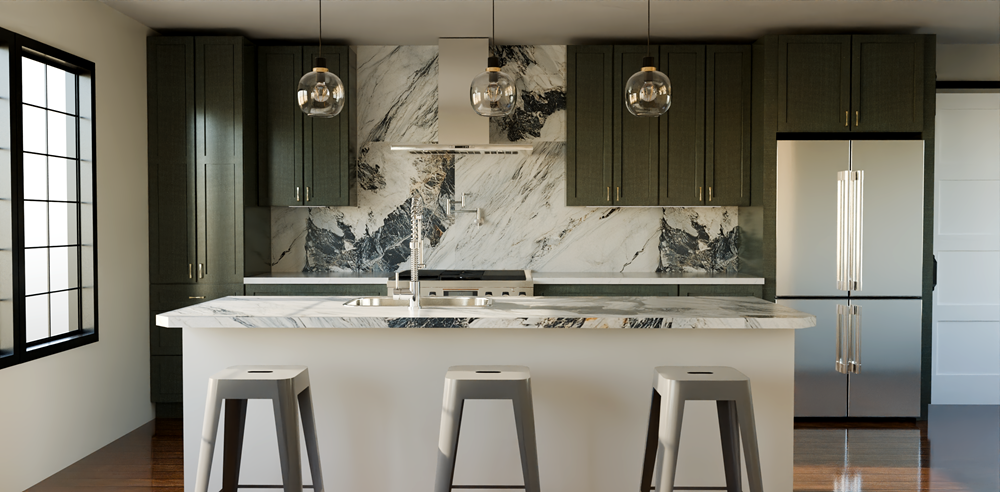How to become an Interior Designer: a step-by-step guide
Kitchen Bathroom

Vanessa Dekoekkoek

Interior design is a dynamic and respected profession that shapes the way we live, work, and interact with our environments. As demand grows for personalized, functional spaces – especially in kitchens and bathrooms – so does the need for skilled, credentialed professionals who understand both form and function.
This guide outlines a professional pathway into interior design, whether you're starting from scratch, switching careers, or building on related experience. We also spotlight key industry partnerships that help elevate the profession, including the NKBA (National Kitchen & Bath Association), NARI (National Association of the Remodeling Industry), and Design Flex's academic program, which equips future designers with real-world knowledge and industry-standard tools.
Understanding the interior design profession
Interior designers are responsible for planning and executing spatial solutions that improve the quality, utility, and aesthetics of built environments. Their work goes beyond decoration. In residential and commercial projects, they:
- Create layout plans and elevations
- Select materials, lighting, and finishes
- Coordinate with contractors and manufacturers
- Ensure compliance with building codes and accessibility standards
Kitchen and bath design, in particular, is a highly specialized niche requiring technical knowledge, creativity, and precision. Many professionals in this space pursue NKBA certification or participate in targeted academic programs that reflect the complexity of modern living spaces.
Exploring your education path: Degrees and alternatives
There is no single route into interior design. Some professionals enter through two or four-year programs; others build credentials through short-form certifications or the less-common apprenticeship route.
Option 1: Formal degree programs
Many colleges and universities offer Bachelor of Fine Arts (BFA) or Bachelor of Science (BS) degrees in Interior Design. Accredited programs (e.g. CIDA-accredited) include coursework in:
- Building systems and codes
- Lighting and acoustics
- CAD and technical drawing
- Sustainability and materials
For those seeking a shorter or more flexible route into the profession, Associate of Applied Science (AAS) or Associate of Arts (AA) degrees in interior design are widely available. These programs often focus on:
- Design fundamentals and space planning
- Materials and finishes
- Residential design
How Cyncly supports interior design student
Cyncly partners with colleges and universities across North America to support aspiring designers through its Design Flex academic program. Students enrolled in participating degree programs gain access to professional-grade digital design tools and hands-on experience with real-world project workflows. This helps them graduate with a career-ready portfolio and confidence using the same technology found in top design studios.
Option 2: Industry-Aligned training programs
Organizations like the NKBA (National Kitchen & Bath Association) and NARI (National Association of the Remodeling Industry) offer focused certification and training programs, especially in kitchen and bath design. These programs emphasize both creative and technical skills. They are ideal for professionals who want to work in high-spec residential projects.
This type of training is especially valuable for those already working in the industry – such as designers, installers, contractors, or sales professionals – who are looking to upskill, specialize, or stay current with evolving trends and technologies. Many certifications require or encourage the completion of continuing education units (CEUs) to maintain credentials and demonstrate ongoing professional development.
Whether you are deepening your expertise or preparing for NKBA certification, industry-aligned training helps ensure your knowledge stays relevant, competitive, and aligned with modern consumer expectations.
Building a portfolio that reflects your skillset
Your portfolio is your most powerful asset. It tells clients, firms, and manufacturers who you are as a designer – and what you're capable of.
Include:
- Floor plans, elevations, and renderings
- Projects with a clear emphasis on kitchen and bath spaces
- Client briefs, design rationales, and material selections
- Evidence of hands-on work or internships
Tip: Organize your portfolio by space type or design style. Use a digital format like a custom website or cloud-based PDF that's easy to share and update.
Certifications that elevate your credibility
To be taken seriously as a professional interior designer, especially in kitchen and bath, it's important to pursue recognized credentials. Certifications not only validate your expertise but also open doors to more advanced projects and professional opportunities.
NKBA certifications
NKBA (National Kitchen & Bath Association) offers highly regarded certifications that demonstrate technical proficiency, safety awareness, and excellence in execution. These include:
- Associate Kitchen & Bath Designer (AKBD) – Designed for emerging professionals with foundational industry knowledge
- Certified Kitchen Designer (CKD) and Certified Bath Designer (CBD) – Focused credentials for experienced specialists
- Certified Kitchen & Bath Designer (CKBD) – A combined credential for seasoned professionals with broad expertise
- NKBA Specialty Badges – For designers looking to grow in targeted areas, NKBA also offers specialty badges. These digital credentials highlight skills in specific topics like: remodeling, cabinetry, sales and marketing, floor plans, appliances, color, sustainability and lighting.
NCIDQ (National Council for Interior Design Qualification)
Required in many U.S. states for licensed interior designers working in commercial or code-compliant environments.
NARI certification
Especially relevant for professionals working on renovation or remodeling projects, NARI certifies advanced knowledge in kitchen design, green remodeling, and project management.
Joining industry organizations and networks
Networking is essential in interior design. Becoming active in industry groups helps you stay informed, connected, and credible.
- Join NKBA and attend local chapter events
- Connect with NARI members and education opportunities
- Look for mentorship and internships through your academic program or Design Flex partner school
These networks provide access to job boards, exclusive training, and peer support. They also increase your visibility within the design community – especially if you're aiming to specialize in residential design.
Tools, skills, and software to master
To succeed as a professional interior designer, you'll need to become proficient with industry-standard tools for planning, visualization, and communication.
Key skill areas include:
- Space planning and layout design
- Lighting design and electrical planning
- Material sourcing and project budgeting
- Client communication and presentation
Design Flex software gives certified professionals access to an integrated platform for space planning, client collaboration, and 3D visualization. Many academic partners incorporate Design Flex into their curriculum to give students a competitive edge.
Other skills to develop: concept sketching, mood board creation, and specification documentation.
Finding work and launching your career
Interior designers can work in a range of settings:
- At design firms specializing in residential or commercial interiors
- Within architectural or remodeling practices
- As freelance consultants or business owners
- In kitchen and bath showrooms that are known for their specialty
To break in:
- Participate in student showcases through your academic program
- Create a digital portfolio with project walk-throughs and testimonials
- Offer pro bono work to small businesses or nonprofits to build your portfolio
- Use your NKBA or NARI credentials in outreach communications and social media
Common roadblocks and how to overcome them
|
Challenge |
Solution |
|
No formal degree |
Earn NKBA or NARI certifications to establish credibility |
|
Lack of experience |
Enroll in a college or university that offers an academic license of Design Flex |
|
Struggling to find work |
Submit your projects in design contests by NKBA or NARI to stand-out |
|
Overwhelmed by tool options |
Start with an academic license of Design Flex to learn best practices |
Remember: You don't need everything at once. Focus on building your body of work and growing your network.
Becoming an interior designer is an achievable goal with the right mix of training, portfolio development, and industry engagement. Whether you pursue a degree, certification, or hands-on apprenticeship, your growth will be shaped by the quality of your network and the value of your work.
Ready to take the next step in your interior design journey? Join thousands of aspiring professionals using Design Flex—the industry-aligned platform that brings your ideas to life.
Related blogs

How brand inconsistency threatens kitchen/bath retail expansion
8/31/2025
A fragmented experience across locations can erode customer trust. Here’s how to preserve your brand while scaling your kitchen and bath business.

Kitchen interior design tips for modern homes: What works and why?
8/13/2025
Explore advanced interior design strategies for kitchens that elevate both function and aesthetics.

3D Kitchen Planner: Full guide to get started
8/8/2025
Discover how a 3D kitchen planner can transform your design process, boost client engagement, and accelerate sales with realistic visualizations and smart automation.